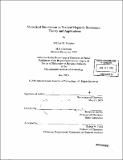Numerical simulations in nuclear magnetic resonance : theory and applications
Author(s)
Veshtort, Mikhail M., 1971-
DownloadFull printable version (9.257Mb)
Other Contributors
Massachusetts Institute of Technology. Dept. of Chemistry.
Advisor
Robert Griffin.
Terms of use
Metadata
Show full item recordAbstract
Exact numerical simulations of NMR experiments are commonly required for the engineering of new techniques and for the extraction of structural and dynamic parameters from the spectra. The calculations can be very demanding, especially in the case of solid-state problems. We propose a number of new algorithms that drastically improve the efficiency of these calculations. Among the most important ones are the integration of the equation of motion of the propagator via Chebyshev expansion of the matrix exponential, explicit utilization of the sparsity of the Hamiltonian, and a novel methodology for the simulation of solid-state NMR experiments. We also describe SPINEVOLUTION, a highly optimized computer program developed based on these advanced techniques to be a powerful and easy to use tool for the simulation and data fitting of general NMR experiments. Benchmarked on a series of examples, SPINEVOLUTION was consistently found orders of magnitude faster than another recently developed and widely popular NMR simulation package SIMPSON. The program should be of great utility to people working in NMR for the design and optimization of new experiments, theoretical research, data fitting, etc. A novel strategy for the efficient design of shaped pulses for NMR experiments was developed and implemented in SPINEVOLUTION. The most important component of this approach is our technique for the global optimization on the space of smooth functions, the Grid Search in the Reduce-Dimension Fourier Space (GREDFOS). A series of low-power amplitude-modulated selective excitation pulses have been developed using this strategy. The pulses of this E-Family provide selective excitation with the precision that was not available previously. The pulses were shown to perform well in both liquid and solid state NMR experiments. (cont.) The Magnus expansion is fundamental to the NMR theory. It also explains the paradoxical success of the integration-by-exponentiation method that has been widely used for the integration of the equation of motion with a time-dependent Hamiltonian. We discuss several aspects of the convergence of the expansion that had been left open so far. An unexpected geometrical picture of the long-term behavior of the effective Hamiltonian of a two-level system is also presented.
Description
Thesis (Ph. D.)--Massachusetts Institute of Technology, Dept. of Chemistry, 2003. Vita. Includes bibliographical references.
Date issued
2003Department
Massachusetts Institute of Technology. Department of ChemistryPublisher
Massachusetts Institute of Technology
Keywords
Chemistry.